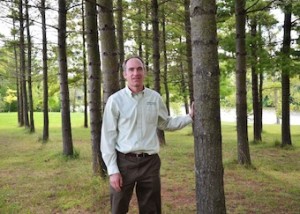EXETER – Professional tree planters from across southwestern Ontario converged on the Ausable Bayfield watershed to see local projects and discuss strategies this past week.
This is the fifth year Trees Ontario has facilitated this tree-planting strategy tour in different areas but it is the first time the annual event has been held in the Ausable Bayfield watershed. Those taking part Nov. 20 included private consultants, stewardship council members, commercial tree nursery representatives, field advisers from Trees Ontario, and staff members from conservation authorities.
Trees Ontario has a mission to increase the forested landscape of Ontario’s private lands through the support and promotion of tree planting programs and by working with partners, government, associations, private and corporate sponsors. The non-profit organization sponsored the tour.
The tree-planting practitioners met at the Ausable Bayfield Conservation Authority (ABCA) workshop east of Exeter to learn about and discuss the equipment and approaches used in this watershed. They toured a variety of tree-planting sites in the watershed from spruce and pine planted in the 1950s at Hay Swamp to more recent multi-species tree planting projects that include restoration of the original hydrology and wetlands to the site in what’s called reverse drainage.
“Reverse drainage and wetland restoration is really important where it can be practically achieved on marginal lands in our watershed,” said Ian Jean, who is an ABCA forestry and land stewardship specialist.
“Storing water for slow release and groundwater infiltration reduces runoff and downstream erosion while filtering contaminants. We get the greatest water-quality benefit on tree-planting projects where we can include wetlands,” he said.
Ausable Bayfield Conservation Authority plants between 45,000 and 65,000 trees annually on private land in partnership with local landowners. Trees Ontario is now the largest provider of funds for tree planting in the watershed through their 50 Million Tree Program. Planting sites must be a minimum of one hectare – or 2.5 acres – to qualify for funding.
“Most of the projects we get that are large enough to qualify for the Trees Ontario funding are retired pasture or fallow land that is too steep, rough or an odd shape to crop,” Jean said.
“Usually these areas are in valley lands or along creeks where planting trees makes sense. More recently we are seeing some farmers plant trees on small one- or two-acre pieces or corners that are no longer practical to crop with the larger equipment. Often we can combine these areas with connecting windbreaks to reach the one-hectare minimum,” he said.
Forest cover in the Ausable Bayfield watershed area is just under 13 per cent. The long-term goal of the conservation authority is to reach 20 per cent forest cover.
“We are fortunate to live in one of the most agriculturally productive areas of the country,” Jean said.
“There is still room for more trees, on less productive land, valley lands and other marginal areas. If we protect what we have and people continue to plant trees, we believe 20 per cent cover is achievable,” he said.
ABCA provides a full-service tree-planting program and works with landowners to access funds from Trees Ontario and other sources to offset the cost of trees and planting. For more information on tree planting and applicable grants, please contact Jeanat 519-235-2610 or toll-free 1-888-286-2610 or by e-mail at [email protected].












One Comment on "ABCA aims for 20 per cent forest cover"
Increasing tree cover in the Ausable -Bayfield watershed to 20% is appreciated. What is the tree cover for the Maitland watershed?